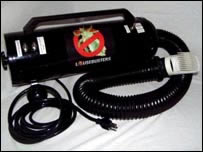'LouseBuster' kills head lice
November 6th, 2006
Utah - A new hairdryer-like device can rid children of head lice by exterminating the eggs and lice.

Test results published in Pediatrics journal show one 30-minute treatment with the device is enough to eradicate infestations by drying the invaders.
The LouseBuster is being developed commercially by a University of Utah spin-off company Larada Sciences.
Patents are pending but the developers hope their non-chemical product will be on the market within two years.
Nits and lice
Head lice are a common problem, particularly among schoolchildren, with some classes suffering multiple outbreaks of the condition, pediculosis, in a single school year.
A single louse can lay dozens of eggs, called nits, in the hair at the rate of three a day.
Lice cannot fly or jump and rely on direct hair-to-hair contact to pass from host to host, although they can be transferred by head contact with contaminated bedding or furniture.
While their bloodsucking activities do cause itching, the infestation is not dangerous in itself, although the host's scratching around can lead to secondary infections of raw areas of scalp.
There are chemical shampoos available to treat the condition, but resistance to these has been steadily increasing over recent years.
Regular head combing is recommended by many experts, although this will not prevent reinfection.
The LouseBuster's co-inventor, Dr Dale Clayton, explained that the device worked by drying the nits and lice out, not by heating them.
He urged parents not to try to do the same at home with a hairdryer.
"We don't want kids getting burned by parents who think it is the heat.
"This thing is actually cooler than a hairdryer, but requires twice as much airflow, and the special hand piece is critical because, unless you expose the roots of the hair, it doesn't work.
"It's difficult to do that with a regular comb," he explained.
In the Pediatrics study showed how best to use the device to exterminate the nits and lice.
When used with a plastic hand piece with 10 coarse teeth, the LouseBuster killed 80% of hatched lice and 98% of louse eggs. This was enough to eliminate entire infestations.
As many as 3 million people a year in the UK catch head lice.
The National Public Health Service for Wales has undertaken research into treatment of head lice in schoolchildren, particularly looking at patterns of resistance to chemical shampoos.
Dr Richard Roberts, Consultant in Communicable Disease Control, Wales, said that work suggested products containing malathion were most likely to be effective.
"High levels of resistance were seen in pyrethroid containing products," he added.
He said wet combing could work for those able to follow the rigorous regime it involves.
© BBC News
|

